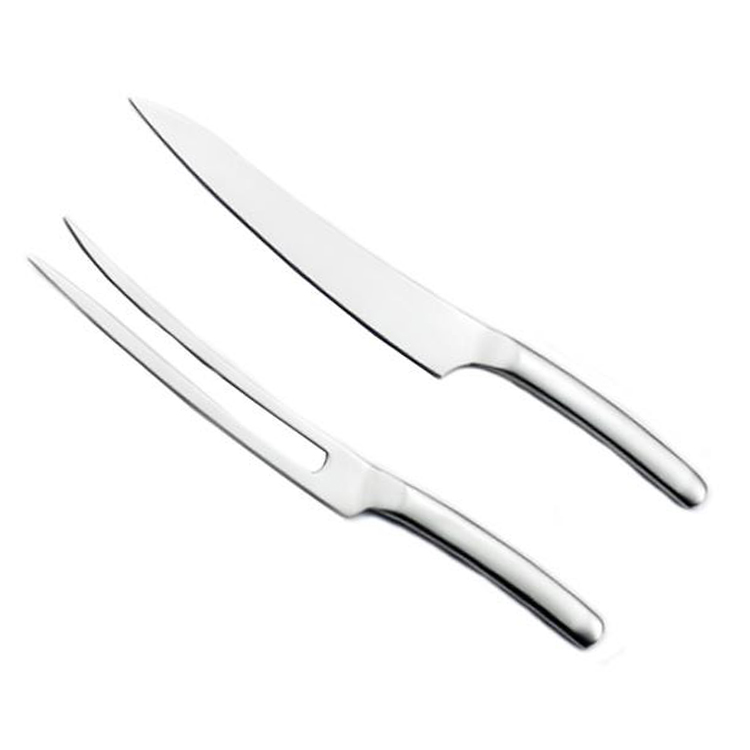Views: 290 Author: Site Editor Publish Time: 2025-11-04 Origin: Site











Content Menu
● Why Maintenance is Important
>> 1. Cleaning Your Carving Knife and Fork Set
>>> Hand Washing
>>> Drying
>> 2. Sharpening Your Carving Knife
>> 3. Storing Your Carving Knife and Fork Set
>>> Proper Storage
>> 4. Handling Your Carving Knife and Fork Set
>>> Rust Removal
Regular maintenance of your carving knife and fork set ensures that they perform optimally. A sharp knife allows for clean cuts, making the carving process smoother and more efficient. Dull knives can tear meat fibers, leading to a less appealing presentation.
A well-maintained knife is safer to use. Dull knives require more force to cut, increasing the risk of slips and accidents. By keeping your knife sharp and in good condition, you reduce the chances of injury while preparing food.
Proper care can significantly extend the lifespan of your carving knife and fork set. Regular cleaning, sharpening, and appropriate storage prevent damage and wear, allowing you to enjoy your tools for many years.
Always hand wash your carving knife and fork set immediately after use. Use warm, soapy water and a soft sponge to clean the blades and handles. Avoid using abrasive cleaners or scouring pads, as these can scratch the surface.
After washing, dry your knife and fork thoroughly with a soft cloth. This prevents moisture retention, which can lead to rust, especially on high-carbon steel blades. Avoid air drying, as this can leave water spots and promote corrosion.
To maintain a sharp edge, sharpen your carving knife regularly. Depending on usage, this could be every few weeks or after several uses. A sharp knife not only performs better but is also safer to use.
- Whetstone: Using a whetstone is one of the best methods for sharpening knives. Hold the knife at a 15-20 degree angle and draw the blade across the stone, alternating sides.
- Honing Rod: Use a honing rod to realign the edge of your knife between sharpenings. This helps maintain sharpness and prolongs the time between full sharpenings.
Store your carving knife and fork in a knife block, magnetic strip, or protective sheath. This prevents the blades from coming into contact with other utensils, which can dull the edge and cause damage.
Avoid storing your knives loose in drawers, as this can lead to nicks and scratches on the blades. If you must store them in a drawer, consider using a knife tray or organizer to keep them separated.
Always handle your carving knife and fork with care. Use the knife for its intended purpose, and avoid using it for tasks like prying or cutting through hard materials, which can damage the blade.
When carving, always use a stable cutting board. This not only protects your knife's edge but also provides a safe surface for cutting. Avoid using glass or stone surfaces, as these can dull the blade quickly.
Periodically inspect your carving knife and fork for any signs of damage, such as nicks, chips, or rust. Addressing these issues promptly can prevent further damage and ensure your tools remain in good condition.
If you notice rust on your knife, remove it immediately using a rust eraser or fine steel wool. After removing the rust, wash and dry the knife thoroughly, then apply a light coat of mineral oil to protect the blade.
If your carving knife and fork have wooden handles, consider applying a food-safe mineral oil periodically. This helps maintain the wood's integrity and prevents cracking or drying out.
While some modern knives are labeled as dishwasher safe, it is generally best to avoid putting your carving knife and fork in the dishwasher. The heat and harsh detergents can damage the blades and handles over time.
If your carving knife and fork set comes with blade guards, use them when storing your tools. Blade guards protect the edges from damage and help maintain sharpness.
Maintaining your carving knife and fork set is essential for ensuring their longevity, performance, and safety. By following these maintenance tips, you can keep your tools in excellent condition, making your cooking experience more enjoyable and efficient. Regular cleaning, sharpening, and proper storage will ensure that your carving knife and fork set remains a reliable companion in the kitchen for years to come.

1. How often should I sharpen my carving knife?
- It depends on usage, but sharpening every few weeks or after several uses is a good practice.
2. Can I put my carving knife in the dishwasher?
- It is best to avoid dishwashers, as the heat and detergents can damage the blades and handles.
3. What is the best way to store my carving knife and fork?
- Store them in a knife block, magnetic strip, or protective sheath to prevent damage.
4. How can I remove rust from my carving knife?
- Use a rust eraser or fine steel wool to remove rust, then wash and dry the knife thoroughly.
5. Should I oil the handles of my carving knife?
- Yes, applying a food-safe mineral oil periodically can help maintain wooden handles.